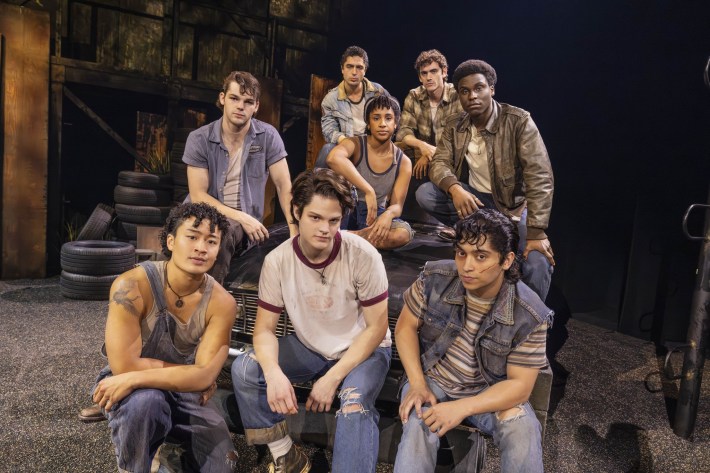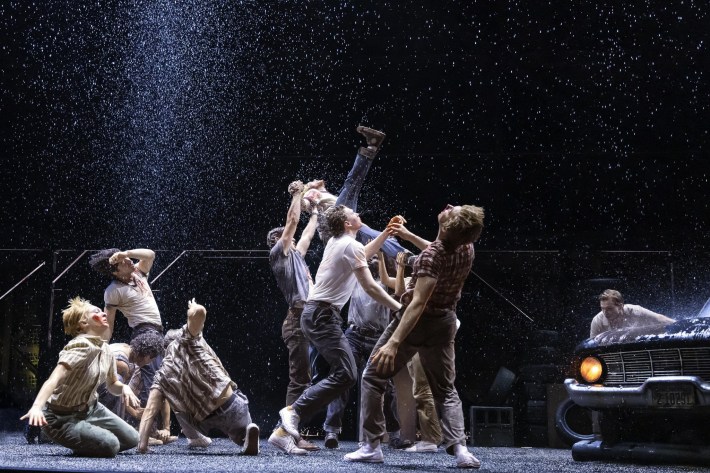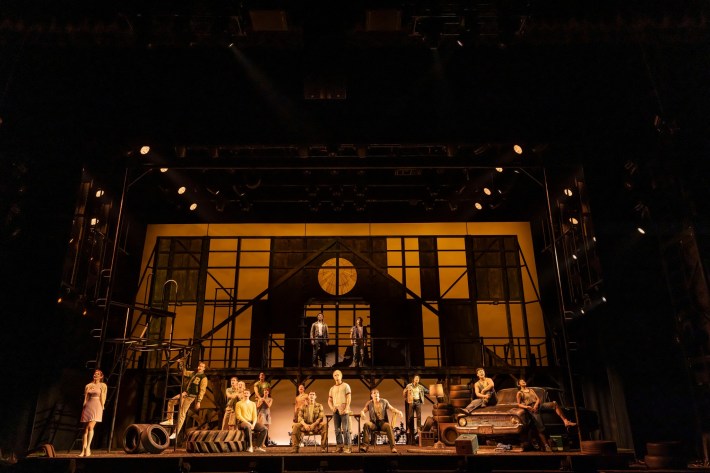"The Outsiders": A New Musical
Tulsa Performing Arts Center
October 8, 2025
If you’ve been marinating in The Lowdown these past few weeks, you’ve gotten a big dose of Tulsa scruff, sleaze, humor, and grit. Sterlin Harjo’s Tulsa jolts and smokes along a track much like the one S.E. Hinton laid down in 1967 with her novel The Outsiders, which got a second pop-cultural life with Francis Ford Coppola’s 1983 film.
In Hinton’s Tulsa, the real insiders are “the outsiders,” the ones most beaten down by society bullshit, who, with a defiant kind of optimism, make a life for themselves inside it. The book gives us a Tulsa—a true one, it seems to me—where fate and history hang heavy, where generational trauma runs through many veins, where social striations feel immovable and territories are firmly marked. It’s also a place where chosen family can be thicker than blood, where dreams run hot but the predominant mode is the Shuffle, where art can be a lifeline out of bitter resignation.
You’ll find a lot of that Tulsa in the Broadway musical The Outsiders, which swept the Tony Awards last year and launched its North American tour in Tulsa this week, with impressive behind-the-scenes help from the PAC and Celebrity Attractions. This show was made by geographical outsiders who are industry insiders, which puts them at a double remove from the Greaser way of life. But they spent a decade building it, including a January 2024 visit to Tulsa. Along the way, as the creative team said during Wednesday’s curtain call, they developed a real affection for this place, and it shows—from the replica of the old wooden Admiral Twin Drive-In screen, to the rose-and-turquoise sunsets, to the care each excellent young actor brings to their role.
Director Danya Taymor comes to The Outsiders from an incredible run directing contemporary plays; she won another Tony this year for John Proctor Is The Villain. With a team of world-class lighting and production designers, she’s created a visual world that marries necessity with love, hard realities with soulful dreams. The stage is full of the stuff of little-city life—a rusted out car, climbable piles of tires, a kitchen table and a single lamp spilling an amber glow—and it all has a lived-with feel, like these kids have been moving these bits of steel and rubber around for years, like their elders before them.

For all the detritus on stage, what you mostly experience are the bodies of these young people, who jostle against each other and toss bits of grit from the ground up into the air, like sawdust confetti. They turn that old car into a concession stand and a bed during the course of the show. In their hands, flashlights are both bedtime reading aids and tools for very literal searching. Defined in some ways by the violence and hardship of their world, these kids are also exuberantly present in it, making a lot out of the little they have.
Realism isn’t musical theater’s strong suit, though, and real-life episodes like a gathering at the drive-in tend to feel ho-hum. When Taymor swings hard in the other direction, taking us fully, even surreally, inside Ponyboy Curtis’ first-person point of view, this production booms with something deep and true.
Frames from a Paul Newman flick flicker across the stage as Ponyboy speaks the book’s opening words (“When I stepped out into the bright sunlight from the darkness of the movie house, I had only two things on my mind: Paul Newman and a ride home”); he comes out to sit in the front row of the audience for a moment, watching it with us. As Ponyboy gets hit by a Soc’s fist, we hear a high-pitched concussive ringing as light flashes and he goes down in cinematic slow motion. Rippled projections, textured like analog film, take us underwater, sound muffled, as his head is held down in a fountain during a fight.
Think you can’t do a jump cut in the theater? Think again: thanks to terrific lighting and sound effects, we literally lose time in the fever-dream, adrenaline-jacked moment when Johnny Cade kills the Soc Bob. And the musical’s rain-drenched rumble—a mini three-act play of its own that takes place in silence—is a masterpiece. In a show full of otherwise basic dance numbers, movement becomes kinetic revelation in this scene, which delivers on the hot, hallucinogenic pulse of Hinton’s world and brings home the metaphor that sometimes who we’re really fighting is ourselves.

While the show’s direction and design push the story’s poetry and heart into 3D reality, much of its music (by Americana duo Jamestown Revival and Justin Levine) hits like a fizz-less Coke on a hot Oklahoma day. There was already a Tulsa Sound when Hinton was writing The Outsiders—The GAP Band formed the year it was published—but that’s not part of the deal here. Our swampy, bluesy, shuffly musical signature has little in common with the conventions and requirements of musical theater numbers, and the composers’ effort to build a bridge between the two through stomp-clappy country-folk produces mostly bland business (including one note-for-note quote from Eddie Cochran’s “Summertime Blues”).
The opening numbers do a lot of literal telling—“my name is Ponyboy Curtis,” “we have no parents,” “I’m a latchkey kid”—that genres like fiction and even film can do gradually and organically through the narrator’s meandering gaze. A few songs, like the ferocious “Run Run Brother” and the gentle “Stay Gold,” reach a moving depth and intensity, in part thanks to full-spectrum vocal performances by Tyler Jordan Wesley (Dallas Winston), Bonale Fambrini (Johnny Cade), and Nolan White (Ponyboy).
The musical’s big anthem, “Great Expectations,” is a complex roil of words and melody that culminates in several genuinely powerful repetitions of its title, sung against a sky full of shifting stars. (The show leans heavily into Ponyboy's identification with Dickens' Pip.) But one line from that song—“Torn between what is and what could be / It's hard to write the story / When the story's writing me”—is enough to give a sense of the flattening effect many of the show’s lyrics produce. Granted, it’s got to be hard to make compelling rhyming verse and engaging musical numbers out of this story’s multilayered adolescent whiplash. I wanted to invite the composers to relax and have a beer, get a little scuzzier: you’re in Tulsa now.
The musical is largely more binary, less full of life, and more pessimistic than the novel, with an overall mood of being trapped that doesn’t ring true for me. Tulsa itself bears the brunt of the doomerism. One song describes the city as a “dead-end road,” and viewers behind me grumbled at a line in the opening number that goes “most people get stuck here for life.” But it’s not Tulsa per se that Ponyboy is dreaming of escaping in the book; it’s the world of class warfare and systemic beat-down. Maybe a musical needs its setting to be more clearly defined than Tulsa can be. This Tulsa is mostly a place to run away from, pretty skies and tender moments or no.
Several other moments feel similarly confusing. Darrel, the famously stoic oldest Curtis brother, spends a whole song whining about his ruined life and aching back (“Runs in the Family”). There’s a weird scene where Ponyboy is officially made a Greaser (complete with the introduction of actual hair grease) after a fight with a Soc—but there’s no initiation ritual needed to become a Greaser. That’s Hinton’s point: it’s something you’re born into, not a social club. But a musical needs a song to introduce the Greasers, so, here we are.
One element that feels very right, given Tulsa's history, is the choice to cast an Indigenous actor as Johnny and a Black actor as Dallas, both here and on Broadway. Both characters are outsiders even in the outsiders’ loyal circle—Johnny with his lost puppy ways, Dallas as the kid from New York who’s been to jail—and their material carries more humor, sweat, and desperate risk than nearly anything else in the musical.

Late in the show, both characters get simple, strong moments that work well (though they don't exist in the book). We see Dallas, the lone wolf who never stopped moving, frozen in front of a train that will take his life. Johnny, the confidante, reappears after his death to sit with a broken, dissociating Ponyboy. As Johnny and Pony hop up on that ratty old bed in unison, we see—rather than being told—that togetherness can be as lasting as it is fragile.
What can you do with what you have? That question applies to people as well as possessions. It also applies to the process of translating fiction rooted in real life into musical theater. How independence is interlocked with connection, choice with fate, love with pain—the Shakespearean themes that swirl through Hinton’s book find their strongest expression here when we’re allowed to just be with them through the bodies of these kids, the gold light spilling through a wrecked movie screen, the daunting physics of action and consequence, and the silence of eyes watching dreams rise and fall like the sun.
Strangely, it’s the more abstract moments that feel the most real in The Outsiders musical, carrying us beyond surface-level music and too-tidy lyrics into a space that the boys (and the original author) might recognize as home.







